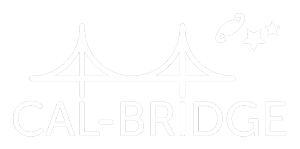Published: August 19, 2025
State investment will expand the program, accelerating efforts to diversify the state’s faculty and STEM leadership pathways.
- $5 million in state funding for Cal-Bridge program with the mission of broadening participation in California’s STEM and tech workforce
- Cal-Bridge creates a pathway for underrepresented students—from community college to Ph.D.—to become leaders in academia and STEM industries
- With proven success and statewide impact, Cal-Bridge is poised to help California build a more inclusive, innovative, and economically powerful tech sector
The 2025 California state budget includes $5 million in support of the Cal-Bridge program, a transformative program reshaping the future of California’s technology workforce by advancing diversity in STEM education and careers.
The funding will support undergraduate scholarships, doctoral and postdoctoral fellowships, undergraduate research, scholar professional development, and program administration. This investment reflects California’s commitment to building a more inclusive and representative STEM workforce.
Alexander Rudolph, Executive Director of Cal-Bridge, emphasized the broader impact of the initiative: “Cal-Bridge is a model of what is possible when we invest in talent that has long been overlooked. This funding will allow us to expand opportunities for underrepresented students across California and help ensure our STEM workforce reflects the diversity of our state.”
California’s tech sector is a cornerstone of its economy, generating over $526 billion annually and employing more than 1.5 million people. Yet, the industry continues to underutilize its human capital: only 15% of tech workers are Black or Latino, and just 26% are women. These disparities are even more pronounced in leadership roles.
“Science and technology are driving the California workforce but much of our state’s potential talent is being left behind, with Black, Latino, and female workers being dramatically underrepresented in these fields. The Cal-Bridge program is a proven way to bring diverse perspectives into STEM fields, supporting students from undergrad through Ph.D. programs and beyond,” said California Assemblymember Mia Bonta, who led the request for funding in the State Assembly.
California State Senator Ben Allen, who also advocated for the program’s funding, noted, “At a time when the federal government is slashing support for our top science and research institutions, California—by providing an investment in the Cal-Bridge program—is stepping up to continue prioritizing this work that provides such important advances in healthcare, energy, and other innovative technologies.”
Cal-Bridge addresses these disparities by creating a comprehensive pathway for underrepresented students from all three segments of California’s higher education system— California Community Colleges (CCC), California State Universities (CSU), and University of California (UC) campuses—to earn STEM PhDs and enter the STEM workforce as faculty or industry leaders.
“I’m proud to have secured $5 million in state funding for the Cal-Bridge program—an investment in California’s first-generation college students who represent our future workforce and innovation economy,” said Assemblymember David Alvarez who chairs the Assembly Budget subcommittee on Education. “These students are advancing into careers as scientists, engineers, and faculty members who will help lead the next generation of research, discovery, and technological progress across our state.”
Over its 11-year history, Cal-Bridge has demonstrated remarkable success:
- 70% of Cal-Bridge scholars who apply to Ph.D. programs are accepted on their first attempt—an unmatched statistic nationwide
- The first two alumni have begun tenure-track faculty positions at public California universities in the past few years
- Hundreds more in the program are progressing through the pathway toward advanced degrees and into the tech workforce of California
At full scale, the Cal-Bridge Initiative could produce up to 2,000 PhDs in science and technology over the next decade, significantly increasing the number of diverse STEM faculty and tech professionals in California.
The program mission aligns closely with the Governor’s Master Plan for Career Education, which calls for dismantling stereotypes and closing equity gaps in STEM fields. With this new funding, Cal-Bridge is poised to accelerate its impact and help California lead the nation in inclusive innovation.
To learn more about Cal-Bridge please visit calbridge.org.
About Cal-Bridge: The Cal-Bridge program has the mission to create a comprehensive, end-to-end pathway for undergraduates from the diverse student population of the CSU system through graduate school to a PhD, postdoctoral fellowship, and ultimately membership in the professoriate and science and technology workforce. Students in the program are referred to as Cal-Bridge scholars.
The program is a partnership between 9 University of California (UC), all 23 California State University (CSU), and the 116 community college campuses in California, thus fulfilling the promise of cross-segmental cooperation envisioned in the California Master Plan for Higher Education. Scholars are recruited from CSU and community college campuses across the state, with the help of local faculty and/or staff liaisons at each campus. Community college students transfer to a participating CSU to join the program.
MEDIA CONTACTS
Alexander L. Rudolph, PhD
Executive Director, Cal-Bridge
Adjunct Professor, Physics and Astronomy
School Of Physical Sciences, UC Irvine
execdir@calbridge.org
